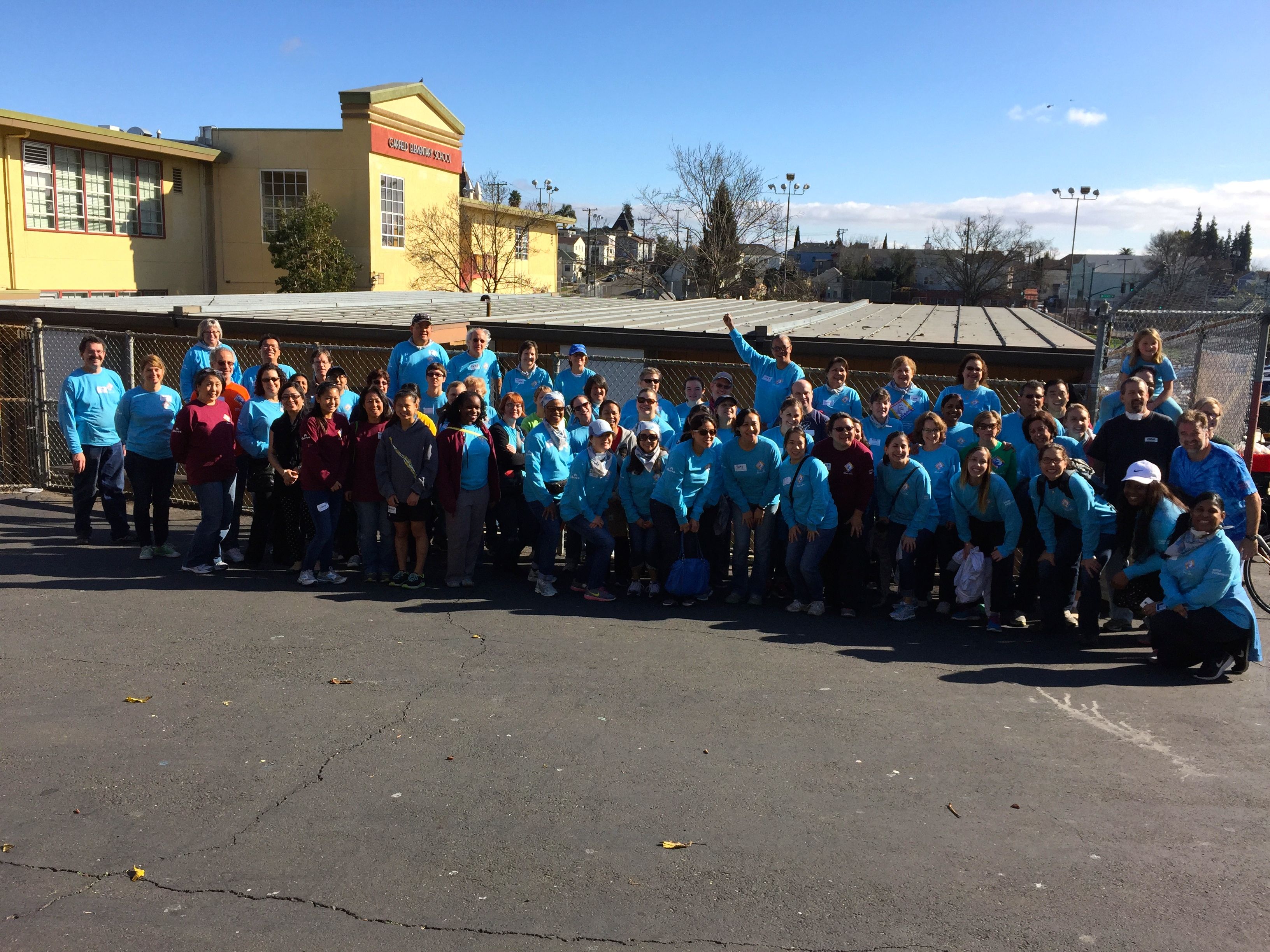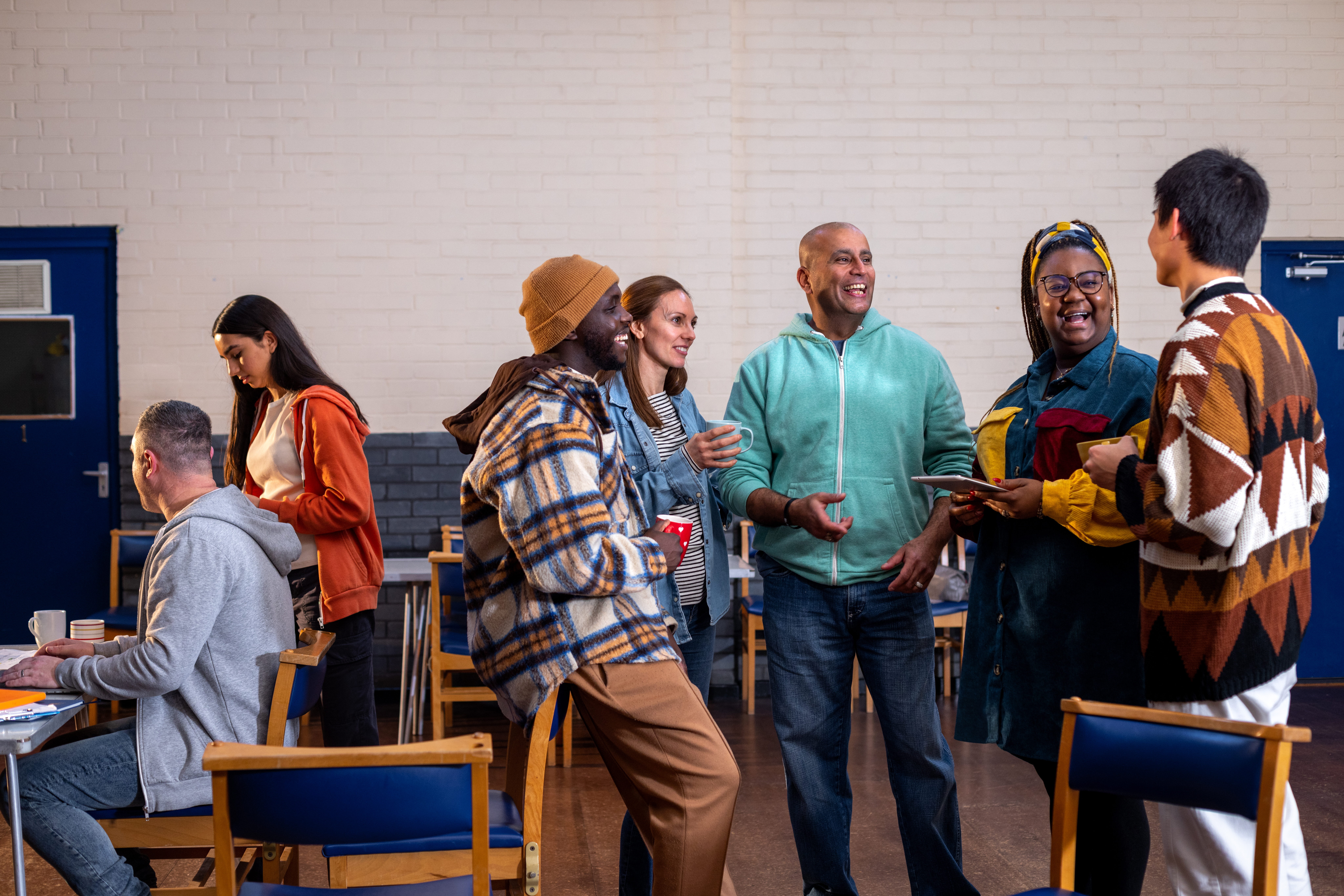Every year on the birthday of Martin Luther King, Jr., thousands of Kaiser Permanente employees take to the streets to celebrate MLK Day of Service. They volunteer their time in schools, senior centers, urban gardens, shelters and other community gathering spaces to honor the legacy of Dr. Martin Luther King, Jr. and to be of service to others. This year was no exception. As an extension of Thriving Schools, many Kaiser Permanente employees devoted their volunteer efforts to enhancing local schools through painting and sprucing efforts, organizing and cleaning, and creating staffroom makeovers. As we gather the photos, memories and stories from this year’s volunteer efforts, we offer up this blog post from 2015 and its reflection on the power of volunteerism to support schools in their efforts to be places of health and well-being.
Reflections on a day of service at Garfield Elementary School in Oakland, Calif.
One of the lesser known quotes attributed to Dr. Martin Luther King, Jr. goes:
“Every man must decide whether he will walk in the light of creative altruism or in the darkness of destructive selfishness.”

The term “creative altruism” in that quote stands out to me, particularly after a day spent in the company of fellow employees from my workplace who went out in droves to schools and community locations across the country in honor of MLK Day of Service.
For the past 11 years, Kaiser Permanente has been encouraging its workforce to celebrate “a day on, not a day off” by using the Martin Luther King, Jr. national holiday to dedicate a day of service to the community. This year, in conjunction with Thriving Schools, the annual celebration of volunteerism took on new meaning as Kaiser Permanente channeled many of its employees to serve in neighborhood schools.
Creative altruism perhaps best captures what I witnessed at Garfield Elementary School in east Oakland where I lent my energies alongside about 50 of my co-workers to transform the school’s drab, worn-out, cluttered hallways and rooms to an existence that was new, spacious, fresh and inviting. Garfield Elementary is the second largest school in the Oakland Unified School District, with a multi-ethnic student body of 580 children, 93% of whom qualify for free or reduced lunches due to their socio-economic status.

Our clean-up efforts were assisted by HandsOn Bay Area, a nonprofit that connects willing groups of volunteers with local nonprofits, schools and parks that are in need of support. With HandsOn Bay Area’s help, volunteers worked to transform the school’s drab, worn-out, cluttered hallways and rooms to an existence that was new, spacious, fresh and inviting.
- A staff meeting room was freshened with a new coat of paint on the closet doors and the addition of newly assembled, sleek and cozy office chairs.
- Hallway bulletin boards were decorated with welcoming messages and lively colors and images.
- Several junk rooms were cleared out, the junk sent off to recycling and garbage bins in favor of utilizing these spaces for organizing school materials in a more thoughtful and easily accessible way.
- And in perhaps the most dramatic transformation was of all, a copy room was transformed into a teacher/staff breakroom, complete with tables and chairs for eating and sharing conversation, a cleaned out refrigerator storage area, freshly painted cabinetry, coffee and tea makers, yoga mats and exercise equipment for light stretching and plenty of colorful and decorative touches. The hope was that such a room would invite teachers into a shared space for taking their breaks, away from their classroom desks and into a safe and protected sanctuary they could call their own.
“It’s amazing to see what a transformation a few dozen volunteers can make in a day,” said Mark Lindberg, my partner in cabinetry painting and cardboard box dismantling for the day. “I had no idea how constrained our public schools are.”
He and I and our third partner, David Marton, followed each other from project to project that morning, trading tips on the best way to avoid tracking paint on carpeted floors and brainstorming how to fix a broken cabinet door handle.
With many public schools feeling the pinch of time and monetary resources, perhaps the power of community volunteerism can be the ultimate conduit for channeling those resources into our schools to create healthy and positive school environments.
Preparation for the day

The key to effective volunteerism is preparation. To be at our most effective, HandsOn Bay Area had to do a great deal of leg-work in advance. Sara Jones, a corporate project leader at HandsOn Bay Area, explained some of what needs to happen behind the scenes:
- Program managers work with school administrators to create a “dream list” of things that the school would like to see accomplished. These lists often include gardening, painting, clean up and special projects.
- Once we received the expected number of volunteers for the project, a person from HandsOn Bay Area is assigned as the program leader to develop the plan of action.
- The program leader then visits the school to create a specific list of volunteer activities that can be accomplished, based on the number of volunteers expected and the allotted budget.
- The program leader orders special purchases (furniture, paint, tools, etc) and sorts them according to the planned activities.
- A team delivers the supplies to the school a few days before the project. They arrive arrived early on the day of the event to set up the tools, food, and supplies.
- The team helps make the magic happen when the volunteers arrive, getting them signed in, motivated and guiding their energy so that they can tackle each activity without interruption.
“I cannot express how helpful it is to have the support of the staff at the school and the volunteers,” explains Sara. “Everyone works together to coordinate an experience that’s powerful and impactful for the whole community.”
Making an impact

“I’d love to see the faces of the students and teachers when they return to school,” exclaimed my volunteer partner, David. “It’s a fitting tribute to Dr. King to be able to do this work.”
Peeked by David’s intrigue, I decided to return to the school the following day to observe the reactions from staff and teachers and see if I could capture a glimpse of what David was seeking.
“It’s an amazing transformation,” said Cathy Perillo, a Special Education teacher who stood in the middle of the newly transformed teacher/staff breakroom. “I think this will definitely promote a sense of community among the staff of the school.”
Yvonne Paige, a first grade teacher for 13 years at the school said, “It’s absolutely beautiful. I mean, it just makes me want to come and grab tea and socialize with other teachers more. It’s so inviting.”
“I think there are many times that we say to ourselves, this is a summer project, we can do this over summer break,” said another teacher speaking about the school’s junk room that had been a dumping ground for decades. “Summer comes and it’s just not what we want to be doing on our break time. So rooms go neglected year after year.”
MLK Day of Service is just one day in a year. And we were only able to touch a few schools with a few volunteer projects this time around. But this year’s efforts had many of us wondering if perhaps walking “in the light of creative altruism,” as King says, is the special strategy, that “secret sauce” to helping schools thrive. With a little elbow grease, time and thoughtful planning, we can set the stage – school by school, community by community – for even greater endeavors that support health and life-long learning and joy.
UPDATE: Here’s a touching video showing the power of volunteerism at Grass Valley Elementary School in Oakland, Calif. on MLK Day.



